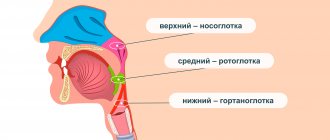Introduction
Chronic pharyngitis is a prolonged inflammatory process of the mucous membrane of the back wall of the pharynx. This is a longer lasting inflammation than acute pharyngitis. Chronic pharyngitis manifests itself in a series of relapses - during an exacerbation, the symptoms return again, and after some time they fade again. Such inflammation can last for years, greatly reducing the patient’s quality of life. Another unpleasant point is the risk of complications: it always persists as long as there is a chronic source of infection in the throat.
Most often, chronic pharyngitis develops due to untreated acute pharyngitis. Also at risk are people whose pharynx is exposed to the negative effects of external factors:
- smoking,
- abuse of alcoholic beverages;
- polluted air in the place of residence;
- inhalation of harmful substances, dusty, polluted air in production.
The main signs of chronic pharyngitis are dryness, soreness and discomfort in the throat.
The disease can manifest itself in several forms. Pharyngitis can develop as an independent disease, or can be combined with chronic tonsillitis. This combination of two ENT conditions is called tonsillopharyngitis.
Treatment methods for pharyngitis in adults
A set of techniques that are used to treat pharyngitis at home:
- foot baths;
- inhalation;
- gargling;
- warm lotions.
to prepare the foot bath . Fill it with hot (not scalding) water and add dry mustard in the amount of one teaspoon.
soothe a sore throat with boiled potatoes in their skins. Drain the boiling water. Cover your head with a large terry towel and inhale the potato steam.
Gargle with infusions of sage or eucalyptus. It is required to pour 10 g of medicinal plant with boiling water in the amount of one glass. Carry out five-minute rinses every hour. The above herbs are also suitable for carrying out the procedure through a nebulizer.
The most effective lotions for treating the throat are prepared using honey. It is necessary to scald the leaves of white cabbage. Apply liquid honey to their surface. Apply the compress to the neck and wrap it in a warm scarf for a quarter of an hour. It is advisable to carry out the procedure at rest. Please note that with prolonged use of honey externally, an allergic reaction is possible.
Causes and course of the disease
Contributors to the occurrence of this disease are: often recurrent acute inflammation of the posterior wall of the pharynx (acute pharyngitis), diseases in the paranasal sinuses, chronic tonsillitis, acute tonsillitis (angina), and inflammatory diseases of the nasal cavity that last for a long time.
The development of chronic pharyngitis is also influenced by the following factors:
- Unfavorable ecological and climatic environmental conditions - dry air, elevated air temperature, dust, gas pollution and dustiness, exposure to harmful chemicals;
- Smoking and alcohol abuse;
- Disorders in the endocrine system, causing hormonal imbalance;
- Diseases affecting the gastrointestinal tract;
- Allergy;
- Dental caries;
- Too spicy food, etc.
Herbs for pharyngitis
To prepare infusions, both one type of medicinal plant and herbal preparations are taken. There are many recipes for preparing them.
- Mix together: 2 tbsp. spoons of eucalyptus, 1 tbsp. a spoonful of thyme, linden blossom and chamomile. Steam two spoons (teaspoons) of the mixture in hot water. Leave for half an hour. After this, strain. Gargle with warm infusion every 120 minutes.
- Take stinging nettle root, saxifrage root, elecampane root, common thyme herb - 1 tbsp. spoon. Mix and pour in the proportion of one glass of boiled water per tablespoon of raw materials. Put on fire for a quarter of an hour. Leave for 20 minutes. Filter. Drink before meals.
- Mix a tablespoon (tablespoon) of oregano, plantain leaves, Veronica officinalis and spring primrose flowers. Pour into an enamel container. Proportions: glass of water for 2 tsp. herbs Leave for two hours and then boil for 5 minutes. Wait until cool, strain. Take one tablespoon before meals.
- Plantain extract. Three times a day, half a teaspoon dissolved in half a glass of water.
Classification of the disease
Chronic pharyngitis has three forms:
- catarrhal,
- hypertrophic (increase in the size of the mucous membrane of the posterior pharyngeal wall),
- atrophic (reduction in size and drying of the mucous membrane of the posterior pharyngeal wall).
The catarrhal form of chronic pharyngitis is characterized by fairly persistent diffuse venous hyperemia (plethora), pastiness (dough-likeness) of the mucous membrane, which occurs due to expansion and stasis (stagnation) in small-caliber veins.
In the hypertrophic form of chronic pharyngitis, thickening is observed in all layers of the mucous membrane, an increase in the number of layers of the epithelium, while the cylindrical ciliated epithelium is replaced by squamous epithelium. The altered epithelium tends to form growths, cystic expansions, thickenings and bays, which are very reminiscent of the lacunae of the palatine tonsils. There is an expansion of small vessels and capillaries. The submucosal layer of the posterior pharyngeal wall thickens and becomes saturated with cellular elements. In connection with the above changes, the mucous membrane becomes denser and thicker, lymphatic and blood vessels dilate, and lymphocytes accumulate in the perivascular space (cracks that exist in the outer membranes of the vessels of the spinal cord and brain).
Lymphatic formations, which look like very small granules scattered throughout the mucous membrane, expand and thicken. The mucous membrane is hyperemic, and hypersecretion is observed (increased secretion production). The hypertrophic process is usually localized on the posterior or lateral wall of the pharynx.
Atrophic chronic pharyngitis is characterized by dryness of the pharyngeal mucosa and its thinning. The cylindrical ciliated epithelium transforms into flat epithelium, which has several layers. At the same time, keratinization is observed in its surface layer. The number of glands decreases, and their canals become overgrown (obliteration process). The mucous membrane looks as if it was covered with varnish.
Quite often, chronic pharyngitis has a mixed form, when, against the background of atrophic changes in the mucous membrane, there are areas of its hypertrophy, which have a dull grayish color with infiltrates that have the form of granules and a rich red color. With a sufficiently pronounced inflammatory reaction, inhibition of factors that are responsible for the state of local immunity is noted.
Clinical picture
The acute form manifests itself:
- sore throat, which sometimes radiates to the ears if the lateral pharyngeal ridges become inflamed;
- a feeling of tickling and burning;
- dryness and discomfort in the throat;
- slight rise in temperature (usually no more than 38.0°C).
When palpating the lymph nodes of the neck, they are determined to be enlarged and painful. Examination of the pharynx reveals redness of its posterior wall and palatine arches, granularity is clearly visible (enlarged lymphoid foci of a brighter color than the surrounding mucosa). An important differential sign is the absence of inflammation in the tonsils with pharyngitis. This distinguishes it from a sore throat.
Chronic inflammatory lesions of the pharynx are easier than acute ones - fever and general deterioration in health are almost always absent. Usually the patient is concerned about:
- feeling of dryness and sore throat;
- dry cough with attacks;
- sensation of a lump or foreign body in the throat.
Due to the fact that mucous secretion accumulates on the back wall, a person constantly needs to swallow it. This causes significant discomfort.
The atrophic type of pharyngitis is accompanied by thinning and dryness of the mucous membrane, through which the vessels are visible. On its surface there may be crusts of dried mucous secretion.
The hypertrophic form is diagnosed by the presence of overgrown foci of lymphoid tissue, which are determined in the form of granules or strands. They are located behind the lateral pharyngeal ridges (these are the posterior arches of the palate). During an exacerbation, hyperplastic areas swell, increase in size, acquire a bright pink color, and foci of abscess formation may appear in them.
Symptoms of chronic pharyngitis
If chronic pharyngitis has a catarrhal or hypertrophic form, then patients complain of tickling, soreness and soreness in the throat. They feel awkward when swallowing and feel as if there is some kind of foreign body in their throat. The listed symptoms are more pronounced in the hypertrophic form, in which patients are bothered by mucopurulent discharge, which quite often flows down the back wall of the pharynx.
Make an appointment right now!
Call us by phone or use the feedback form
Sign up
When an atrophic form of pharyngitis occurs, patients complain of dryness, painful sensations when swallowing, and the inability to eat salty or spicy foods. Sleep disturbance may occur due to severe dryness in the throat, and in some cases, pain when breathing through the throat.
Patients' complaints regarding the existing morphological picture in the mucous membrane are very variable, that is, they have many options. In some patients, complaints are more pronounced even with minor pathological changes than in patients with more severe inflammation.
Acute pharyngitis
Most often, acute pharyngitis is infectious in nature and in 70% of cases is associated with acute respiratory viral infections (ARVI)1,4. In the autumn-winter period of epidemics, rhinoviruses predominate among pathogens (80%), adenoviruses, influenza and parainfluenza viruses are slightly less common1,4.
Pharyngitis can also be caused by bacteria. Among them, group A beta-hemolytic streptococcus is considered especially dangerous. It is found with pharyngitis in 15-30% of children and 5-17% of adults1. In 90% of cases, the disease is caused by several microbes at once1. Much less often, inflammation of the pharynx is caused by fungal flora1.
Pharyngitis can also be the result of allergic reactions or accompany infections such as measles, rubella and scarlet fever1. In each case, the treatment will be different. Therefore, before looking for a cure for pharyngitis, you need to make sure that it is not a symptom of other diseases.
Acute pharyngitis is sometimes caused by factors that have nothing to do with the activity of microbes: damage to the mucous membrane of the pharynx by rough food, bones and other foreign bodies, thermal and chemical burns of the mucous membrane, for example, when consuming too hot and spicy food or strong alcohol1,4.
Symptoms of acute pharyngitis
The clinical picture may include1:
- sore and sore throat;
- feeling of dryness;
- pain when swallowing, especially with an “empty” throat;
- general malaise (weakness, lethargy and drowsiness during the day);
- increased body temperature;
- unpleasant sensations of tingling and congestion in the ears associated with inflammation of the nasopharynx;
- enlargement and tenderness of the lymph nodes located under the lower jaw1,4.
When examining the throat, the mucous membrane looks red, and individual inflamed lymphoid nodules are visible on its surface1.
Diagnosis of the disease
Making a diagnosis is usually not difficult. The main diagnostic method is pharyngoscopy - direct examination of the pharynx. To identify the causative agent of the disease, the patient is sent by an ENT doctor to conduct a series of laboratory tests: a general, biochemical blood test, and a throat smear.
To identify the cause of chronic pharyngitis, additional tests may be needed to locate the site of primary infection. The patient may undergo:
- X-ray or CT scan of the paranasal sinuses;
- endoscopy of the nasopharynx;
- gastroscopy.
Sore throat and pharyngitis: what is the difference?
The general condition of the patient with acute tonsillitis or tonsillitis can be confused with the symptoms of pharyngitis. If the disease is diagnosed incorrectly, then treatment of pharyngitis in adults will not have any effect. And the acute form of the pathology can develop into a chronic one.
Unfortunately, many patients self-medicate and start using medications without a doctor’s specific prescription. This is extremely contraindicated! It is better to take care of your health in time and seek help from an experienced otolaryngologist.
It is important to remember that during pharyngitis, the larynx becomes inflamed, and during tonsillitis, the tonsils become inflamed. During a sore throat, it is always painful to swallow, and the pain intensifies even more when eating food. With pharyngitis, the opposite happens - while eating warm food or warm drinks, the sore throat decreases.
During the development of a sore throat, there is no cough or sore throat, only a sore throat and sometimes the formation of a white coating. With pharyngitis, there is a sore throat, as well as noise, pain, or congestion in the ears. The difficulty in distinguishing between these two diseases is further complicated by the fact that one patient can simultaneously develop both pathologies, since they are caused by the same pathogen.
Treatment of chronic pharyngitis
The goal of treatment on an outpatient basis is to relieve subjective discomfort in the pharynx and normalize the pharyngoscopy picture. It is necessary to carry out sanitation of foci of infection that have arisen in the upper respiratory tract. For all forms of chronic pharyngitis, a prerequisite is quitting smoking and compliance at work and at home with all measures to protect the respiratory tract from harmful factors.
Inhalation gives a good effect. In this case, aerosols from decoctions of chamomile, eucalyptus, sage, mineral alkaline water are used in combination with oil mixtures from sea buckthorn, rose hips, etc.
When treating the hypertrophic form of chronic pharyngitis, cauterization of granules and lateral ridges of the pharynx is used. It can be medicinal, using medicinal solutions (silver nitrate or triacetic acid) or physical, using physical factors (radio wave coagulation, ultrasonic coagulation, laser exposure, cryotherapy, cold and argon plasma, etc.).
Friends! Timely and correct treatment will ensure you a speedy recovery!
In the treatment of chronic atrophic pharyngitis, the mucous membrane is lubricated with iodine-glycerin, and gargling with water-glycerin and alkaline solutions is prescribed.
Chronic pharyngitis often occurs as a consequence of a disease of the gastrointestinal tract. In this case, it is necessary to consult a gastroenterologist and, under his supervision, treat dysbiosis and examine the flora in the gastrointestinal tract.
If the cause of the development of chronic pharyngitis is diseases or disorders of the hormonal, endocrine and cardiovascular systems, it is necessary to undergo examination by a specialized specialist and continue treatment with his participation.
Physiotherapy is often prescribed to treat chronic pharyngitis. You can use electrophoresis in the submandibular areas using a 0.5% solution of nicotinic acid, exposure to a low-energy therapeutic laser or alternating magnetic field, ultrasonic medicinal irrigation of the posterior pharyngeal wall, ultraviolet irradiation and vibroacoustic therapy sessions.
Drugs for the treatment of pharyngitis
Often, an experienced doctor prescribes a complex of drugs, which includes drugs for local and internal use.
To rinse the cavity you can use: Furacilin, Rotokan, Chlorphilipt, Orasept.
Sprays and lozenges: Yox, Hexasprey, Ingalipt, Propasol, Kameton, Isla-mint, Camphomen, Septolete, EM-Kurunga.
To treat purulent pharyngeal plugs, use solutions: Lugol, Stomatidin, Water Peroxide.
In order to strengthen the immune system, take vitamin complexes: Imudon, Duovit, Alphabet, Florenta.
Antibiotics are most often prescribed for prevention in adults, but if there is a risk of complications, they can also be taken by children. The most popular: Augmentin, Erythromycin, Lincomycin, Zinat, Macropen.
It is important to remember that only a doctor can prescribe the correct treatment. Self-administration and the wrong combination of medications may not bring the desired result, harm your health or worsen your condition.
Complication
Possible complications of chronic pharyngitis are:
- Peritonsillar abscess is a purulent inflammation that develops due to bacterial pharyngitis caused by streptococcal infection.
- A retropharyngeal abscess is a purulent inflammation of the tissue located in the retropharyngeal space.
- Laryngitis is an inflammatory process affecting the mucous membrane of the larynx.
- Chronic bronchitis develops when the infection descends lower into the bronchi and causes inflammation in them.
- Systemic inflammatory diseases (glomerulonephritis, myocarditis, rheumatism) - chronic inflammation of the pharynx can cause complications on the kidneys, heart and joints.
- Atrophic processes of the pharyngeal mucosa. The most dangerous consequence of this condition is the development of oncological processes in the pharynx.
Other treatments for pharyngitis
In addition to medicinal plants used for inhalation, compresses and preparation of infusions for internal use, there are additional methods for treating pharyngitis.
You can use propolis . It is necessary to add a teaspoon of tincture to warm water (half a glass). Carry out the rinsing procedure with freshly prepared mixture.
Cocoa butter helps relieve cough. Add half a teaspoon of the ingredient to heated milk (1 glass). Drink four times a day.
Relieves symptoms of inflammation of the pharynx - blackberries . Use the leaves of the plant in the form of a solution for rinsing and inhalation procedures. You should also add vitamin-rich fruits to your daily diet.
To soften the throat mucosa, shake egg whites with a teaspoon of rosehip oil. Lubricate the throat with the resulting mixture or you can drink it.
Prevention of chronic pharyngitis
Prevention of chronic pharyngitis includes significant adjustments to habits and lifestyle - this is the only way you will reduce the risks of developing the disease.
Preventive measures to prevent the development of chronic pharyngitis include:
- timely treatment of acute pharyngitis and other inflammatory ENT diseases;
- reducing cases of contact with irritating harmful substances at work and allergens;
- cessation of smoking and drinking alcoholic beverages;
- treatment of gastrointestinal diseases;
- limiting the consumption of spicy and sour foods;
- strengthening the immune system;
- avoiding crowded places during ARVI epidemics;
- maintaining the required level of humidity and temperature in the room.
Prevention
To prevent pharyngitis, it is enough to follow some simple rules:
- protect the body from hypothermia;
- limit contact with sick people;
- stop smoking;
- wash your hands regularly (especially before eating);
- maintain body hygiene;
- carry out wet cleaning in the house;
- ventilate the room;
- drink enough liquid.
To avoid illness, you should take care of your health, eat well and take vitamins.
Where to treat chronic pharyngitis in Moscow?
Treatment of chronic pharyngitis in Moscow is carried out in various medical institutions, ranging from district clinics to large multidisciplinary network clinics. The cost of treatment and the quality of services in this case cannot be the same everywhere.
The most affordable way to treat the disease is to enroll in a clinic at your place of residence. Affordable, but not the simplest or most effective. As a rule, in district clinics, appointments with an otorhinolaryngologist are quite dense, and it is very difficult to get a ticket “here and now.” You will have to wait about two weeks for an appointment (during this time, the exacerbation of chronic pharyngitis will only gain momentum), or try to get through the “live” queue, sitting all day at the ENT doctor’s office. By the way, it is not always possible to do this the first time.
Now about the quality of treatment - the doctor in the clinic has the task of accepting as many patients as possible. Everything is logical: there are many patients, one doctor. This means that the consultation time is very limited in time. But in the 10 minutes allocated for each patient, it is impossible to fully collect anamnesis and conduct an examination, let alone give effective prescriptions and carry out therapeutic manipulations. Another problem of district clinics is the lack of sophisticated, modern equipment, so the choice of treatment procedures used by the doctor is very limited. Treatment often comes down to prescribing medications that only relieve symptoms for a short time. Treatment for chronic pharyngitis can be very long and tedious.
Many patients are treated in multidisciplinary network clinics, with which they have an agreement to provide treatment under the VHI policy. In such clinics, the treatment process itself often becomes a secondary issue. It takes a doctor a lot of time to fill out medical documentation correctly, because filling it out incorrectly can lead to problems with the insurance company. Therefore, an impressive part of the reception is spent on “paper” work. Another drawback of such clinics, which patients often complain about, is the appointment of unnecessary procedures and unnecessary consultations. Network clinics need a constant flow of patients: the more people come, the more doctors or services they visit, the better. The quality of treatment under such conditions fades into the background.
The third option is treatment in highly specialized private clinics that deal with one particular medical area. Insurance companies are not interested in such clinics, so there will be no flow of people here. Highly specialized clinics, as a rule, are well equipped with medical equipment, which allows high-quality diagnostics and treatment to be carried out in one place. For the treatment of chronic pharyngitis, which requires increased attention and experience of an ENT doctor, this option is the most acceptable.
Warming up
Often the throat becomes inflamed as a result of hypothermia. Therefore, along with the above-mentioned treatment methods at home, warming is worthwhile.
- Honey compress with aloe . 8 tsp. Mix middle-aged aloe juice first with 100 grams of vodka, and then add 50 ml. honey Place the resulting mixture on a cloth and fix until it cools.
- Vodka . Soak gauze or any natural fabric in vodka and apply it to the neck. Cover the top with cellophane and secure with a handkerchief or scarf for two hours. Use no more than four days.
- Camphor . Rub your throat, back and chest with camphor oil. Cover with oilcloth and wrap yourself in a warm blanket.
- Garlic with oil . An oil-garlic compress fights the disease very well. To prepare it, chop the garlic. Combine with butter. Apply the mixture to your throat. Wrap cling film over the top. Wrap yourself in a blanket. Leave for four and a half hours.
Note! Do not use medical alcohol to avoid chemical burns.
When are antibiotics needed?
If, after the results of a pharyngeal smear are obtained, it is determined that the disease is bacterial in nature, antibiotic drugs are prescribed. Antibiotics for pharyngitis can be prescribed for local (local) or general action. The choice of a specific drug depends on the patient’s condition and his individual characteristics. Thus, during pregnancy, a woman (if antibiotics cannot be avoided) is prescribed mainly local drugs for irrigating the pharynx, since they penetrate into the systemic bloodstream to a lesser extent.
The use of antibiotics is required in order to stop the proliferation of the pathogen and destroy it. Thanks to this, drugs in this category help prevent the spread of the inflammatory process to surrounding tissues. In the first days of taking antibiotics, an increase in temperature is the norm, since due to the large number of dead pathogens, the body becomes intoxicated. The duration of taking antibiotics is at least 5 days. If you stop the course earlier, bacteria resistant to the drug will form, which will make its use ineffective. Each specific drug has its own contraindications, which must be taken into account when prescribing the drug.
Side effects from taking general antibiotics may include:
- fever;
- joint pain;
- disturbances in intestinal function;
- general weakness.
Such manifestations are considered normal and, as a rule, do not require replacement of the drug. However, if they develop, you must inform your doctor about this.
For pharyngitis, penicillin drugs or cephalosparins are most often used. If they are not tolerated by the patient, treatment is carried out using Azithromycin, Amoxiclav, Lincomycin, Erythromycin or Amoxicillin. Antibiotics for pharyngitis in adults and children are prescribed the same.
In the chronic form of the disease, pharyngitis without antibiotics is treated only until it worsens. If this occurs, antibiotics are prescribed.
Treatment of viral pharyngitis.
As already mentioned, antibiotic therapy for viral pharyngitis will not be an effective treatment. Moreover, there is no so-called causal treatment. Viral pharyngitis is a disease that goes away on its own; treatment is symptomatic. The most widely used antipyretic drugs are those whose active ingredient is paracetamol. Antipyretic and anti-inflammatory drugs are also used
- these include, for example, compounds related to non-steroidal anti-inflammatory drugs, the active ingredient of which is ibuprofen.
For nasal discharge, topical medications are used to relieve nasal congestion. Thanks to local action, active ingredients
almost immediately enter the infected area. In case of fever, it is also recommended to drink plenty of fluids to keep the body hydrated.
Many medications used to treat viral pharyngitis are available without a prescription. So you can buy them yourself without visiting a doctor. However, you should read these instructions carefully and adhere to the prescribed doses. In addition to symptomatic treatment
Rest and reduction in physical activity are also necessary.
Why does pharyngitis occur?
An inflammatory reaction on the pharyngeal mucosa can be caused by:
- exposure to too cold or hot air;
- contact with aggressive chemicals;
- too dusty and polluted atmosphere;
- smoking as a special case of inhalation of toxins;
- traumatic damage to the mucous membrane as a result of surgical interventions or removal of foreign objects from the pharynx.
Very often the cause is infection. Inflammation can be caused by both bacteria (mainly streptococci and staphylococci), viruses and even fungi (for example, the genus Candida). Infectious agents can immediately affect the mucous membrane of the pharynx or spread to it from the teeth and sinuses. Therefore, to get rid of pharyngitis, it is necessary to first destroy third-party infectious foci.
In addition to direct causes, inflammation can be caused by:
- decreased immunity;
- vitamin deficiency;
- pathologies of the digestive tract and liver;
- cardiovascular, renal and pulmonary failure;
- difficulty breathing through the nose;
- allergic disorders;
- endocrine system disorders.









